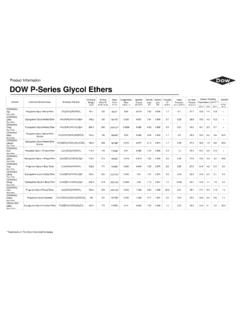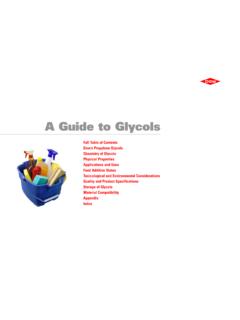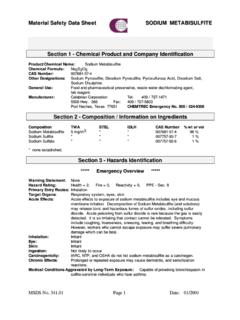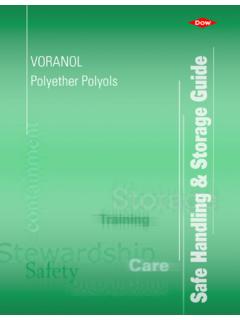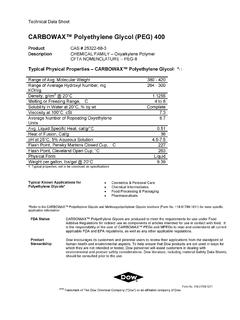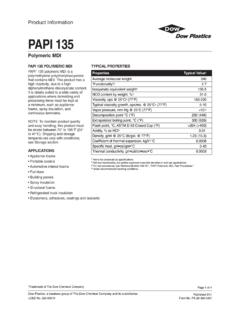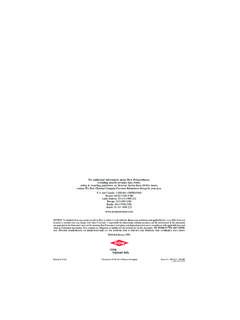Transcription of Revised: February 2005 CYCLOTENE 4000 Series ... …
1 CYCLOTENE advanced electronic Resins revised : February 2005 CYCLOTENE * 4000 Series advanced electronic Resins ( photo BCB) Processing Procedures for CYCLOTENE 4000 Series photo BCB Resins DS3000 Immersion Develop Process 1. Introduction The CYCLOTENE 4000 Series advanced electronic resins are I-line-, G-line-, and broad band-sensitive photopolymers that have been developed for use as dielectrics in thin film microelectronics applications. These polymers are derived from B-staged bisbenzocyclobutene (BCB) chemistry and have final film properties that are similar to the dry etchable 3000 Series . Products are listed in Table 1. Those products with XU designation are developmental products. Please inquire about the availability of these formulations. A puddle or spray develop process, using DS2100 develop, is also available.
2 See our processing guide Processing Procedures for CYCLOTENE 4000 Series Resin (Puddle Develop). Properties of CYCLOTENE resins are shown in Tables 2-4 and Figure 1. Additional information on CYCLOTENE resins can be found on the web site, Table 1. photo -BCB Formulations CYCLOTENE resin Viscosity (cSt) Cured Thick-ness1 ( m) XU35133 34 XU35132 96 4022-35 192 4024-40 350 4026-46 1100 XU35075 1950 15 30 1 Not to be construed as product specification * Trademark of The Dow Chemical Company Table 2. Electrical and Thermal Properties of photo -BCB ( CYCLOTENE 4000 resin Series ) Property Value Dielectric constant (1kHz 20 GHz) Dissipation factor Breakdown voltage MV/cm Leakage current x 10-10 A/cm2 at MV/cm Volume resistivity 1 x 1019 -cm Thermal conductivity W/m K at 24 C Thermal stability weight loss per hour at 350 C Table 3.
3 Mechanical Properties of photo -BCB ( CYCLOTENE 4000 resin Series ) Property Value CTE 42 ppm/ C at 25 C Tg >350 C Tensile modulus GPa Tensile strength 87 9 MPa Elongation at break 8 Poisson ratio Stress on Si at 25 C 28 2 MPa Material Arrival and Storage Photosensitive CYCLOTENE advanced electronic resins are shipped frozen in dry ice. If your shipment arrives with no dry ice and is warm, please contact your local Dow representative. Processing Procedures for CYCLOTENE 4000 Series photo -BCB Resins (Immersion Develop Process) 1 CYCLOTENE advanced electronic Resins Table 4. Equilibrium wt % Water in photo -BCB at Various RH at 23 C CYCLOTENE resin Film thickness ( m) Relative Humidity (%) 30 54 84 4024-40 5 4026-46 10 4026-46 20 Table 5.
4 Recommended Storage Temperatures and Times Storage Need Temperature Shelf Life Long term Freezer (-15 C) 1 year from date of manufacture Medium term Refrigerator (4 C) 1-2 months Short term Clean room (20 C) 5 days Figure 1. Weight loss from a 10 m film of CYCLOTENE 4026-46 resin by isothermal TGA under nitrogen at 350 C Precipitation of photo additives can sometimes occur with CYCLOTENE 4022-35 resin, and occasionally with CYCLOTENE 4024-40. The additive readily re-dissolves upon warming to room temperature. Should this occur, some gentle mixing of the contents is desirable to ensure a homogeneous solution. An alternative is to remove the product from the dry ice and store it at -30 C to -40 C, as we have found that it is the transition from -78 C to -15 C that tends to initiate crystallization. Storage As photosensitive CYCLOTENE resin ages, the spun-on thickness will gradually increase.
5 The lifetime is based on the criterion of less than 5% change in thickness. Resins should be allowed to equilibrate to room temperature before use. Recommended storage conditions and times are shown in Table 5. 2. PROCESSING Several process options are available, and are shown in Figure 2. Process A uses a hot plate soft bake and includes a develop end point monitor with each lot. Process B uses a hot plate soft bake and a pre-develop bake to stabilize the develop end point. (See below for further description of these process options.) An oven soft bake is also possible. The process that you choose is dependent on tool availability and manufacturability requirements. Step 1. Surface Preparation Substrates to be coated with CYCLOTENE resin should be free of all organic impurities and other contaminations prior to coating. A clean surface is important to ensure good adhesion.
6 An example of a cleaning procedure is an oxygen plasma clean, followed by dump rinse and spin-rinse dry. Step 2. Adhesion Promoter Adhesion promoter is recommended whenever the resin is to be adhered to any exposed metal or inorganic (silicon oxide, silicon nitride, alumina) surfaces. For example, we recommend adhesion promoter application between multiple coatings of BCB if there is metal sandwiched between the two BCB layers. The recommended adhesion promoter is AP3000, which is anProcessing Procedures for CYCLOTENE 4000 Series photo -BCB Resins (Immersion Develop Process) 2 CYCLOTENE advanced electronic Resins Figure 2. Process Flows for CYCLOTENE 4000 Series advanced electronic Resins organosilane coupling agent in an organic solvent.
7 It comes pre-mixed and does not require further mixing or dilution. We recommend the use of AP3000 for most surfaces, including silicon dioxide, silicon nitride, silicon oxynitride, aluminum, copper, titanium and chromium. For other surfaces, contact your Dow representative for any more recent information. Adhesion promoter is applied by dispensing statically or dynamically to cover the surface of the wafer. The wafer is then spun dry at 3000 rpm for 10-20 seconds. 1 Surface Clean 4A Hot Plate Soft Bake 5 Expose 6 End Point Monitor 2 Adhesion Promoter 3 Spin Coat BCB 4B Hot Plate Soft Bake 7 Pre-develop Bake 5 Expose 8 Immersion Develop 9 Post-develop Bake (optional) 10 Cure 11 Plasma Descum Process A Process B Processing Procedures for CYCLOTENE 4000 Series photo -BCB Resins (Immersion Develop Process) 3 CYCLOTENE advanced electronic Resins Though usually not required, the adhesion to surfaces such as silicon nitride, silicon oxide, copper, and aluminum, can be enhanced by baking the adhesion promoter, for 30 seconds at 100 - 150 C, depending on surface, prior to BCB application.
8 Step 3. BCB Coating Equipment It is recommended that coaters be equipped with two dispense heads ( CYCLOTENE resin and adhesion promoter) backside rinse and EBR capability, hot plates and bowl exhaust. Coating Process photo BCB films are spun onto the substrate directly after the adhesion promoter application and spin dry. The precise conditions used to deposit the resins ( spin speed) will vary according to the final film thickness desired and which formulation of resin is being used. Table 6 shows thickness vs spin speed for CYCLOTENE 4022-35, 4024-40, and 4026-46 resins after soft bake (see section 4) and final thickness after exposure, development, and cure. Most of the loss in film thickness in the final, cured film occurs during the develop step. The loss in film thickness during the cure step (other than removal of residual developer solvent) is less than 5%.
9 The thicknesses in Table 6 were determined using an open spin bowl. If a covered or closed cup coater is used, the thicknesses will differ and will depend on spin time as well as spin speed. Figure 3 shows a comparison of film thickness using open and closed bowl configurations. Thicknesses of the developmental photosensitive products are shown in Table 7. Final hard cured film thickness is also a function of subsequent processing steps, including soft bake conditions, exposure dose and develop-ment as explained in those sections below. Dispense Resin Dispense a puddle of resin of 1-5 ml (depending on topography, substrate size and resin viscosity) on the wafer. The dispense can be static or dynamic (10 - 100 rpm). Spread Increase the substrate speed to 500 rpm for approx. 5 10 seconds to spread the resin out from the center of the substrate.
10 Spin Increase the substrate speed to a rate that will achieve the desired pre-exposure thickness (see Tables 6, 7). Backside rinse during spin of CYCLOTENE 4026-46 resin during the spin process will help suppress polymer filament ( cotton candy ) formation. Table 6. Typical CYCLOTENE 4000 Series advanced electronic resin thicknesses after soft bake, and final thicknesses after full photo processing and hard cure (not to be construed as product specification). 4022-35 thickness ( m) 4024-40 thickness ( m) 4026-46 thickness ( m) Spin speed (rpm) After soft bake Final thickness After soft bake Final thickness After soft bake Final thickness 1500 2000 2500 3000 3500 4000 5000
